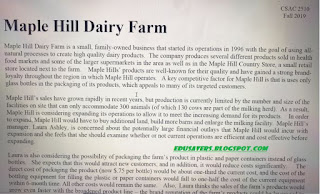Assess the competitive environment of Maple Hill Dairy Farm and determine what you think is or should be Maple Hill’s competitive strategy and explain why. Evaluate Laura’s plan to move from glass bottles to plastic and paper containers.
Answer:
Competitive environment of Maple Hill Dairy Farm
Based on the
information provided by the case study, Maple Hill Dairy Farm is a small
family-owned business. They take pride in their high-quality dairy products
produced and sold in health food markets, supermarkets, and Maple Hill Country
Store. The popular products have provided an excellent competitive environment
by providing strong brand loyalty among the customers in the region. The
environment makes it possible for the organization to control the sales
price in an attempt to gain more customers and earn more market share.
Maple Hill’s competitive strategy
Part of Maple Hill’s
competitive strategy includes packing its products in glass bottles which is
appealing to many of its targeted customers. Even though using glass bottles
has proven to be expensive, the strategy can be seen as a competitive factor
that attracts customers to purchase the products in the region.
Laura’s plan to move from glass bottles to plastic and paper containers
Laura is concerned
about the financial outlay that the organization would incur upon the
expansion. To minimize costs and attract more customers, she plans to move from
glass bottles to plastic and paper containers. The current direct cost of
packaging the product in a glass bottle is $.75 per bottle, which is expensive
compared to packaging the farm’s product in plastic and paper containers.
Therefore, the plan can be considered cost-effective, considering it will
reduce the packaging costs by about one-third of the current cost. Similarly,
the cost of the bottling equipment for filling the plastic or paper containers
would fall to one-half the cost of the current equipment within six months.
However, all other operational costs would remain the same. Therefore, the use
of plastic or paper containers and the brand reputation of the farm’s products
could be leveraged to attract new customers and increase sales. The plan can
also serve well in attracting new supermarkets and other retailers that do not
presently handle bottles.
Determine the unit costs for each of the five products given the available information. How could you improve on these calculations? What additional information would your request, and how would you use it?
Answer:
The unit costs for the
products
A unit cost can also
be explained as the cost of goods sold (COGS), which is the total expenditure
incurred to produce, store, and sell one unit of a particular product. Given
the available information, the unit costs for each of the five products include
the following:
- Chocolate Milk - $1.90
- Eggnog - $2.25
- Low-Fat Milk- $1.90
- Skim Milk- $1.90
- Whole Milk- $1.90 per quart
How to improve the calculations
Some of the ideal ways
to reduce cost per unit include reducing the overhead costs and increasing
product sales. The calculations can also be improved by finding less expensive
materials to use and evaluating the production processes to look for ways to
make them more efficient.
Additional information required
Improving the
calculations for unit costs would also require additional information showing
the overall costs involved in producing the products offered by Maple Hill
Dairy Farm. The information can be portrayed by a cost sheet statement which
consists of factory costs, premium costs, cost of goods sold (COGS), and total
costs. Thus, collecting, analyzing, and reporting the cost information can
serve well in improving the calculations. In addition, the information makes it
easier to produce an effective budget, forecasting and monitoring the costs.
3. Use the information in the case above to determine the ABC-based unit costs for Maple Hill’s products. How does this information help Laura analyze her decision regarding the change in containers from glass to plastic and paper?
Answer:
The activity-based
costing (ABC) is a system that determines the costs of overhead activities and
assigns them to the products. The ABC-based unit for Maple Hill’s products
involves tracing resource consumption and cost per unit. The approach enhances
the reliability of cost data to determine the true costs. It has also been
utilized in classifying the costs incurred by the company during its production
process for the products per unit. Thus, the information can be valuable for
Laura in analyzing her decision regarding the plan to change from glass to
plastic and paper bottles. In addition, it shows that Maple Hills can continue
serving its customers with quality dairy products even after the changes are
implemented.


No comments:
Post a Comment